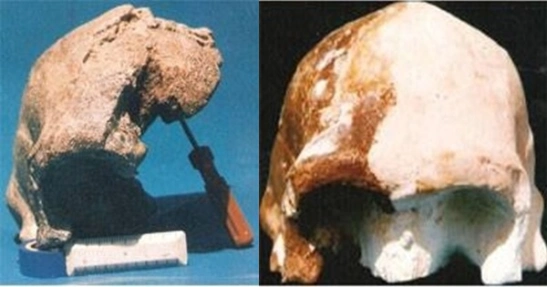Skull found in Hathnora Village, in Narmada belt in 1982 is of a Homo Sapien dating to 1.5-2.5 lakh years back


The most intriguing fossil of a human progenitor was discovered by geologist Arun Sonakia in the Madhya Pradesh town of Hathnora on the banks of the Narmada in December 1982. Homo erectus, the species that existed before Homo sapiens sapiens, the modern human species, is where the Narmada Man, formerly belonged as per the previous study. Between 1.8 million and 200,000 years ago, Homo erectus is thought to have lived on Earth.
Interestingly, the research study done by American scholars Kenneth A R Kennedy & John Chiment known as “The Fossil Hominid from the Narmada Valley, India: Homo Erectus or Homo Sapiens” states that the fossil belongs to Homo sapien dating back to 150000 to 250000 years ago. The study states, “On 6-10 April 1984, Sonakia (1985a) displayed a cast of the specimen to palaeoanthropologists attending the international Ancestors symposium held at the American Museum of Natural History, New York, a brief description appearing the following year in Ancestors: the Hard Evidence edited by Delson (1985)- In the summer of that same year, Sonakia joined Marie-Antoinette de Lumley at the Institute de Pala%oontologie Humaine in Paris for a more rigorous study of the original specimen.” It added, “Palaeoanthropologists who had observed the cast of Narmada Man at the Ancestors conference or were familiar with the few published sources that stated its classification as Homo erectus.”
The study further states that based on artifact typology and stratigraphic dating of the deposit, the most recent investigation of the area by a team from the Physical Research Laboratory at Ahmedabad places the antiquity within the middle to late middle Pleistocene dates. This gives a time range of approximately 250,000 to 150,000 years for the calvaria of Narmada.
It described that the right side of the cranium is completely intact, but the left side of the cranium is only partially preserved. The specimen used for the morphometric analysis was three-quarters of a calvaria, with portions still covered in a compact basal conglomerate of hard gravel. The face is restricted to a piece of the right orbit, and the majority of the basalar sections are presewed. All bone tissue is strongly calcified, yet there were neither teeth nor a mandible to be found.
The Narmada calvaria is the only middle Pleistocene hominid discovery from the Indian subcontinent that has been preserved and authenticated, and its position in the middle of the continents with richer fossil hominid sites in Eurasia and Africa ensures that it will always hold a special place in human paleontology.
In conclusion, the author state that those who agree that Homo erectus is a valid taxon for widely dispersed hominid populations of the middle Pleistocene, some referring to it as a “evolved” form under the premise that Homo erectus is the ancestor of all modern humans, will lend support to those who believe Narmada Man is an Indian Homo erectus. But their final analysis places the Narmada Man calvaria in the Homo sapiens genus challenging the claim of ancestry of humans belonging to Africa.
This discovery challenges the “out of Africa” theory that summarily says that Between 100 and 200,000 years ago, Homo sapiens evolved initially in Africa then migrated over the globe and displaced all other hominid species. This theory implies that all contemporary individuals have ultimately descended from Africans.
DISCLAIMER: The author is solely responsible for the views expressed in this article. The author carries the responsibility for citing and/or licensing of images utilized within the text.
